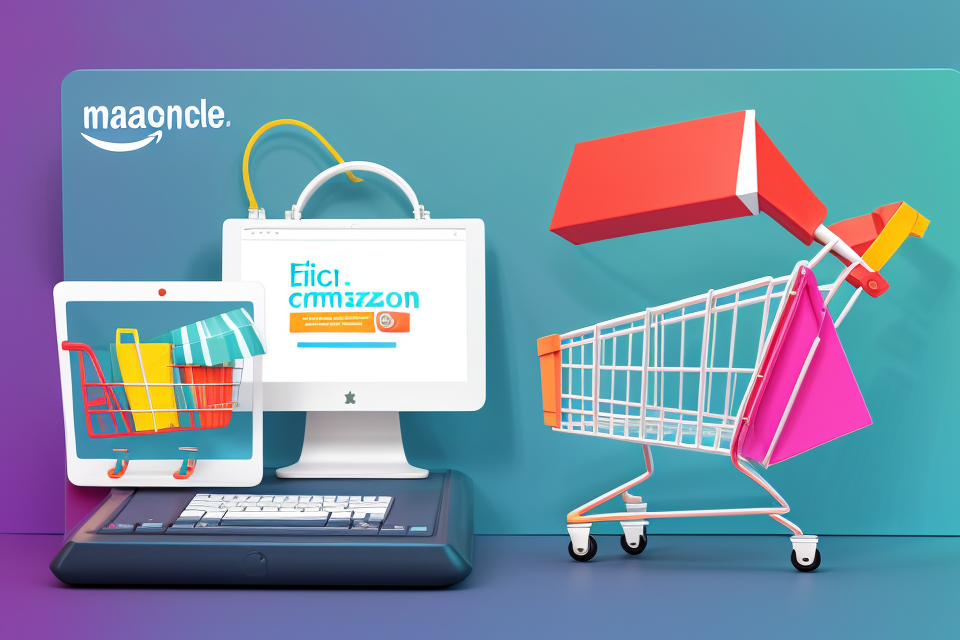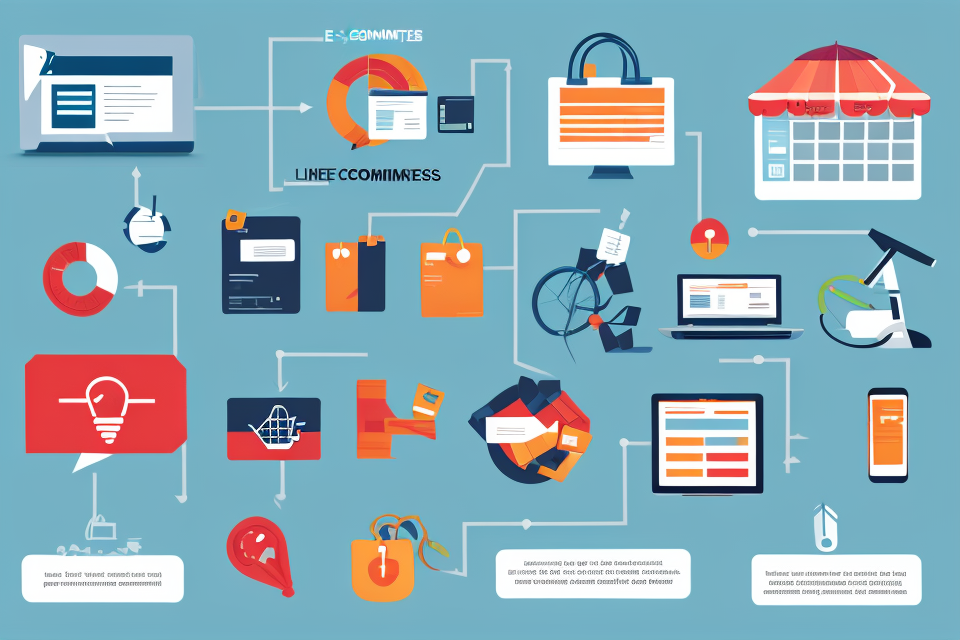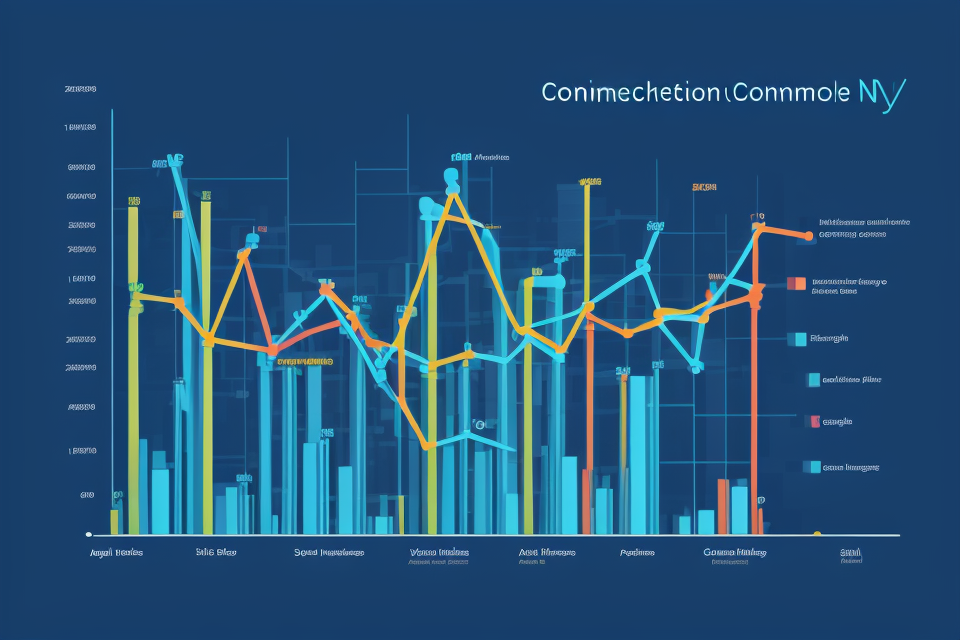E-commerce, short for electronic commerce, refers to the buying and selling of goods and services online. With the rise of the internet and advancements in technology, e-commerce has become a vital part of modern business. It has transformed the way we shop, conduct transactions, and connect with businesses.
Example:
One example of e-commerce is online retailers like Amazon and Alibaba. These companies offer a wide range of products from various sellers, and customers can easily browse and purchase items through their websites. Another example is online food delivery services like Grubhub and Uber Eats, which allow customers to order food from their favorite restaurants without having to leave their homes.
Key Concepts:
To understand e-commerce, it’s important to familiarize yourself with some key concepts such as business-to-consumer (B2C), business-to-business (B2B), and consumer-to-consumer (C2C) transactions. B2C refers to transactions between a business and an individual customer, while B2B involves transactions between businesses. C2C refers to transactions between individual consumers. Additionally, understanding the different types of e-commerce models, such as dropshipping and subscription-based models, can also help you better understand this growing industry.
What is E-Commerce?
Definition of E-Commerce
E-commerce refers to the buying and selling of goods and services, or the transmitting of funds or data, over an electronic network, primarily the internet. This term encompasses a wide range of business transactions, from online shopping to digital payments and online transfers of funds. The key components of e-commerce include the following:
- Online retail: This includes the buying and selling of physical goods online, such as through online marketplaces like Amazon or Alibaba.
- Electronic data interchange (EDI): This refers to the transfer of business documents, such as purchase orders and invoices, between companies electronically.
- Online auctions: This includes the buying and selling of goods through online auction platforms, such as eBay.
- Online marketplaces: These are websites or platforms that allow businesses to sell their products or services to customers online.
- Digital payments: This includes the use of electronic payment systems, such as credit cards, debit cards, and digital wallets, to make purchases online.
- Online advertising: This includes the use of online advertising platforms, such as Google AdWords and Facebook Ads, to promote products or services to potential customers.
E-commerce has become an increasingly popular way for businesses to reach customers and for customers to shop, as it offers convenience, accessibility, and a wide range of products and services. With the continued growth of the internet and the rise of mobile devices, e-commerce is expected to continue to play a significant role in the global economy.
Types of E-Commerce
B2B (Business-to-Business) E-Commerce
B2B e-commerce refers to the online transaction of goods and services between businesses. This type of e-commerce typically involves large quantities of products or services being purchased by other businesses, rather than individual consumers. B2B e-commerce is an essential aspect of many businesses’ operations, allowing them to purchase supplies, raw materials, and other goods at a lower cost and with greater efficiency.
B2C (Business-to-Consumer) E-Commerce
B2C e-commerce is the online transaction of goods and services between businesses and individual consumers. This type of e-commerce has grown rapidly in recent years, as more and more consumers turn to the internet to purchase products and services. B2C e-commerce allows consumers to purchase a wide range of goods and services from the comfort of their own homes, including clothing, electronics, and groceries.
C2C (Consumer-to-Consumer) E-Commerce
C2C e-commerce refers to the online transaction of goods and services between individual consumers. This type of e-commerce has grown significantly in recent years, particularly with the rise of online marketplaces such as eBay and Amazon. C2C e-commerce allows consumers to sell goods and services to one another, often at a lower cost than traditional retail outlets.
C2B (Consumer-to-Business) E-Commerce
C2B e-commerce refers to the online transaction of goods and services from individual consumers to businesses. This type of e-commerce is less common than other types of e-commerce, but it does exist. For example, a consumer may offer a service such as graphic design or writing to a business through an online platform.
Understanding the different types of e-commerce is essential for businesses looking to establish an online presence or expand their existing e-commerce operations. Each type of e-commerce has its own unique characteristics and requires different strategies for success.
Advantages of E-Commerce
- Convenience: One of the most significant advantages of e-commerce is the convenience it offers to both customers and businesses. With e-commerce, customers can shop from the comfort of their own homes, at any time of the day or night, and have their purchases delivered directly to their doorstep. Businesses, on the other hand, can reach a global audience without the need for physical stores.
- Cost Savings: E-commerce can also lead to cost savings for both customers and businesses. Customers can save money on transportation and other expenses related to shopping in-store, while businesses can save on overhead costs such as rent, utilities, and inventory management.
- Access to a Wider Range of Products: E-commerce allows businesses to offer a wider range of products to customers, as they are not limited by physical space. This means that customers have access to a greater variety of products, including those that may not be available in their local area.
- Increased Competition: E-commerce has also led to increased competition among businesses, as it allows smaller companies to reach a wider audience and compete with larger corporations. This can result in better prices and more innovative products for customers.
- Data Collection and Analysis: E-commerce platforms allow businesses to collect and analyze data on customer behavior, preferences, and purchasing habits. This can help businesses to improve their marketing strategies and better understand their target audience.
- Increased Customer Engagement: E-commerce platforms also provide businesses with the opportunity to engage with customers in new and innovative ways, such as through social media, email marketing, and customer reviews. This can help to build customer loyalty and improve the overall customer experience.
E-Commerce Examples
Successful E-Commerce Companies
When discussing successful e-commerce companies, it’s essential to understand the criteria used to determine their success. These companies typically excel in several key areas, such as customer experience, product selection, pricing, and marketing strategies. Some of the most well-known and successful e-commerce companies include:
- Amazon: As the world’s largest online retailer, Amazon offers a vast array of products, from books and electronics to household goods and clothing. Its success can be attributed to its ability to provide a seamless customer experience, competitive pricing, and an extensive selection of products. Amazon also leverages its vast customer data to provide personalized recommendations, further enhancing the customer experience.
- Alibaba Group: Alibaba is a Chinese multinational conglomerate specializing in e-commerce, retail, Internet, and technology. Its flagship platform, Taobao Marketplace, and Tmall.com are among the world’s largest online shopping platforms. Alibaba’s success can be attributed to its ability to adapt to local markets, its strong focus on customer service, and its innovative approach to online payments and logistics.
- Shopify: Shopify is a leading e-commerce platform that enables businesses to set up and manage their online stores. Its success lies in its ability to provide a user-friendly platform that is customizable and scalable, allowing businesses of all sizes to create professional-looking online stores. Shopify’s success can also be attributed to its robust app ecosystem, which provides merchants with a wide range of tools to improve their online stores’ functionality and performance.
- Zappos: Zappos is an online retailer known for its wide selection of shoes, clothing, and accessories. Its success can be attributed to its commitment to customer service, offering free shipping and returns, and its unique company culture, which emphasizes employee happiness and work-life balance. Zappos has built a loyal customer base by prioritizing customer satisfaction and experience, demonstrating the importance of this aspect in the e-commerce industry.
These successful e-commerce companies have carved out their niches in the market by focusing on various aspects of the e-commerce experience. They have demonstrated that providing a superior customer experience, offering competitive pricing, and leveraging technology can lead to significant success in the e-commerce landscape.
Examples of E-Commerce in Everyday Life
Online Retailers
One of the most common examples of e-commerce in everyday life is online retailers. These are businesses that sell products or services directly to consumers through their websites. Some popular examples of online retailers include Amazon, Etsy, and Zappos.
Online Marketplaces
Another example of e-commerce in everyday life is online marketplaces. These are platforms that connect buyers and sellers, allowing them to transact directly with each other. Examples of online marketplaces include eBay, Upwork, and Airbnb.
Online Services
E-commerce also encompasses online services, such as streaming media services like Netflix and Hulu, as well as software-as-a-service (SaaS) products like Dropbox and Slack.
Digital Goods
Digital goods, such as music, e-books, and software, are also sold through e-commerce channels. This can include online stores run by individual creators, as well as larger platforms like Apple’s App Store and Google Play.
Mobile Commerce
Mobile commerce, or m-commerce, is a growing area of e-commerce. This includes transactions that are conducted through mobile devices, such as smartphones and tablets. Examples of m-commerce include mobile banking, mobile ticketing, and mobile shopping.
Overall, e-commerce has become an integral part of everyday life for many people, offering a convenient and efficient way to purchase a wide range of products and services.
Key Concepts in E-Commerce
Online Payment Systems
- Overview: Online payment systems play a crucial role in facilitating e-commerce transactions by enabling secure and efficient exchange of funds between buyers and sellers through the internet. These systems eliminate the need for traditional paper-based methods, such as checks and money orders, and offer a range of payment options to cater to diverse consumer preferences.
- Key Components: The main components of an online payment system include the payment gateway, payment processor, and payment methods. The payment gateway is responsible for encrypting sensitive financial information during transactions, while the payment processor handles the transfer of funds between the buyer’s and seller’s accounts. Payment methods refer to the various ways in which consumers can pay for their purchases, such as credit cards, debit cards, e-wallets, and bank transfers.
- Security Measures: Ensuring the security of online transactions is paramount for both buyers and sellers. Online payment systems employ various security measures, such as encryption, authentication, and fraud detection tools, to protect sensitive financial information and prevent unauthorized access. These measures include SSL encryption, 3D Secure, and fraud detection algorithms that analyze transaction patterns to identify suspicious activities.
- Benefits: Online payment systems offer several benefits to both buyers and sellers. For buyers, the convenience of paying with a few clicks, without the need for physical cash or paperwork, enhances the overall shopping experience. For sellers, the ability to reach a wider customer base, the reduced costs associated with handling cash and paper-based payments, and the access to real-time transaction data enhance the efficiency and profitability of their business operations.
- Challenges: Despite the numerous benefits, online payment systems also pose some challenges. These include concerns over the security and privacy of financial information, potential fraud and hacking threats, and the need for robust and reliable technical infrastructure to support the transaction processing. Additionally, the varying regulatory requirements and compliance standards across different jurisdictions can create complexity and uncertainty for businesses operating in multiple markets.
- Future Trends: The future of online payment systems is likely to be shaped by emerging technologies, such as blockchain and artificial intelligence, which have the potential to enhance security, efficiency, and customer experience. Mobile payment options, such as mobile wallets and contactless payments, are also expected to gain popularity, driven by the increasing use of smartphones and the convenience they offer. Moreover, the growing adoption of digital currencies, such as Bitcoin, presents both opportunities and challenges for the evolution of online payment systems.
Marketing Strategies for E-Commerce
E-commerce marketing strategies involve creating, promoting, and selling products or services through online platforms. To effectively market e-commerce businesses, entrepreneurs must understand the target audience, leverage technology, and implement innovative marketing techniques. This section explores some essential marketing strategies for e-commerce success.
- Identifying the target audience:
To create a successful e-commerce marketing strategy, it is crucial to identify the target audience. Understanding the demographics, preferences, and behaviors of potential customers enables businesses to tailor their marketing efforts and create personalized experiences. This process involves conducting market research, analyzing customer data, and utilizing analytics tools to gain insights into customer behavior. - Developing a strong brand identity:
A strong brand identity helps e-commerce businesses differentiate themselves from competitors and build customer loyalty. Establishing a consistent brand image across all marketing channels, including website design, social media, and advertising, is essential. This includes using a unique logo, consistent color schemes, and a clear brand message that resonates with the target audience. - Utilizing search engine optimization (SEO):
SEO is a crucial e-commerce marketing strategy that helps businesses improve their visibility on search engines like Google. Optimizing website content with relevant keywords, meta descriptions, and alt tags for images can increase organic traffic and improve search engine rankings. Additionally, creating high-quality, informative content that addresses customer needs and provides value can enhance the user experience and encourage repeat visits. - Leveraging social media:
Social media platforms are powerful marketing tools for e-commerce businesses, as they allow entrepreneurs to engage with customers, build brand awareness, and drive sales. Creating a social media presence on platforms like Facebook, Instagram, and Twitter requires regularly posting engaging content, running targeted ads, and interacting with followers to foster a sense of community. - Implementing email marketing campaigns:
Email marketing is an effective e-commerce marketing strategy that enables businesses to nurture customer relationships and drive sales. Creating targeted email campaigns, offering exclusive discounts, and providing personalized product recommendations can encourage customer engagement and increase conversion rates. - Utilizing influencer marketing:
Influencer marketing involves partnering with social media influencers who have a significant following in the e-commerce industry. By collaborating with influencers, e-commerce businesses can increase brand awareness, reach new audiences, and build credibility. This strategy requires selecting influencers who align with the brand’s values and target audience, and creating authentic content that resonates with their followers. - Offering a seamless user experience:
Providing a user-friendly online shopping experience is essential for e-commerce success. This includes optimizing website speed, ensuring mobile responsiveness, and offering convenient payment options. A seamless user experience can increase customer satisfaction, improve brand loyalty, and encourage repeat purchases.
By implementing these marketing strategies, e-commerce businesses can effectively reach their target audience, build brand awareness, and drive sales. Understanding the unique challenges and opportunities of the e-commerce landscape is crucial for entrepreneurs looking to establish a competitive edge in the market.
The Future of E-Commerce
As the world becomes increasingly digitized, e-commerce continues to grow and evolve at an unprecedented pace. With the rise of new technologies and changing consumer preferences, it is essential to understand the future of e-commerce and its potential impact on businesses and society as a whole.
Emerging Technologies
One of the most significant factors shaping the future of e-commerce is the emergence of new technologies, such as artificial intelligence (AI), virtual reality (VR), and blockchain. AI-powered chatbots, for example, can provide personalized recommendations to customers, while VR can offer immersive shopping experiences that replicate physical stores. Blockchain technology, on the other hand, can enhance transparency and security in online transactions.
Another key trend shaping the future of e-commerce is the increasing importance of mobile commerce. With more consumers accessing the internet through their smartphones and tablets, businesses must optimize their online stores for mobile devices to remain competitive. This includes designing mobile-friendly websites, offering mobile apps, and implementing mobile payment options.
Sustainability and Ethical Consumerism
As consumers become more conscious of the environmental and social impact of their purchases, sustainability and ethical consumerism are becoming increasingly important in e-commerce. Businesses that prioritize sustainability and ethical practices, such as using eco-friendly packaging and sourcing materials ethically, are likely to attract and retain customers who value these factors.
Globalization
Finally, the future of e-commerce is likely to be shaped by globalization, as businesses increasingly expand their online operations to reach international markets. This will require businesses to navigate complex regulatory frameworks, cultural differences, and logistical challenges to succeed in foreign markets.
In conclusion, the future of e-commerce is shaped by a combination of emerging technologies, changing consumer preferences, and globalization. By understanding these trends and adapting to them, businesses can position themselves for success in the rapidly evolving world of e-commerce.
Challenges and Limitations of E-Commerce
E-commerce, while offering numerous benefits and opportunities, also faces various challenges and limitations. Understanding these obstacles is crucial for businesses looking to establish or enhance their online presence.
- Security Concerns: One of the primary concerns in e-commerce is the security of transactions and personal information. Hackers and cybercriminals constantly target online platforms, making it essential for businesses to invest in robust security measures, such as encryption and secure payment gateways.
- Trust and Reputation: Building trust and establishing a positive reputation is essential for the success of an e-commerce business. However, customers may be hesitant to make purchases online due to concerns about the authenticity of products, delivery times, and customer service.
- Accessibility and Usability: To ensure that e-commerce websites are accessible to all customers, businesses must design their platforms to be user-friendly and accessible to people with disabilities. This includes providing alternative text for images, ensuring proper color contrast, and offering a range of payment options.
- Delivery and Logistics: E-commerce businesses face logistical challenges, such as ensuring timely and efficient delivery of products, managing inventory, and dealing with returns and refunds. Effective logistics management is critical for customer satisfaction and retention.
- Payment Processing: Accepting and processing payments is a crucial aspect of e-commerce. Businesses must ensure that their payment systems are secure, reliable, and convenient for customers, while also considering the costs associated with payment processing.
- Regulatory Compliance: E-commerce businesses must comply with various laws and regulations, such as data protection, consumer protection, and tax requirements. Failure to adhere to these regulations can result in legal consequences and damage to the business’s reputation.
- Global Expansion: Expanding an e-commerce business into new markets can be challenging due to differences in cultures, languages, and legal systems. Businesses must carefully research and understand the specific requirements of each market to ensure successful expansion.
- Technological Advancements: E-commerce businesses must continuously adapt to new technologies and trends, such as mobile commerce, social media, and artificial intelligence. Keeping up with these advancements requires significant investment in research and development.
Understanding these challenges and limitations of e-commerce can help businesses develop strategies to overcome them and ensure their long-term success in the digital marketplace.
FAQs
1. What is e-commerce?
E-commerce refers to the buying and selling of goods and services online through the internet. It includes the exchange of information, data, and funds between buyers and sellers through digital channels.
2. What are some examples of e-commerce?
Examples of e-commerce include online retail stores such as Amazon and Alibaba, online marketplaces like eBay and Etsy, online booking platforms like Airbnb and Booking.com, and online payment systems like PayPal and Stripe.
3. What are the key concepts of e-commerce?
The key concepts of e-commerce include the use of the internet for buying and selling, the exchange of digital information and funds, the use of online platforms and marketplaces, and the integration of technology into the business model.
4. What are the benefits of e-commerce?
The benefits of e-commerce include increased convenience and accessibility for consumers, lower costs for businesses, improved efficiency and speed of transactions, and the ability to reach a wider audience.
5. What are the challenges of e-commerce?
The challenges of e-commerce include security and privacy concerns, the need for reliable and fast internet connectivity, the competition from other e-commerce businesses, and the need for effective marketing and customer service.
6. How has e-commerce evolved over time?
E-commerce has evolved over time from simple online stores to complex marketplaces and platforms that offer a wide range of products and services. It has also become more integrated with social media and mobile devices, and has seen the emergence of new technologies such as artificial intelligence and blockchain.
7. What is the future of e-commerce?
The future of e-commerce is likely to see continued growth and expansion, with the rise of new technologies and business models. It is also likely to see increased competition and consolidation, as well as the emergence of new players in the market. Overall, e-commerce is expected to continue to play a major role in the global economy.



